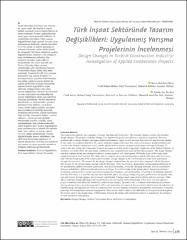Türk İnşaat Sektöründe Tasarım Değişiklikleri: Uygulanmış Yarışma Projelerinin İncelenmesi
Künye
ÖKTEN, Burcu BALABAN & Zahide Nur BAYKAN. "Türk İnşaat Sektöründe Tasarım Değişiklikleri: Uygulanmış Yarışma Projelerinin İncelenmesi". Tasarım Kuram, 19.39 (2023): 278-295.Özet
İnşaat sektörünün hızlı karar alan dinamik
bir yapısı vardır. Bu dinamik iş yapma
kültürü, içerisinde tasarım değişikliklerini de
barındırmaktadır. Tasarım değişikliklerinin
amacı genel olarak projelerin kalitesini ve
verimliliğini arttırmaktır. Fakat, tasarım
değişikliklerine bağlı yaşanan sorunlar, proje
performansını düşürerek, yeniden işlemelere
(rework), zaman ve maliyet artışlarına ve
kalitenin düşmesine neden olabilmektedir.
Bu çalışmada Türk inşaat sektöründe tasarım
değişikliklerinin sebepleri ve bu sebeplerin
proje performansına etkilerinin alan
çalışması üzerinden tespit edilmesi
amaçlanmıştır. Bu amaca ulaşmak için,
Türkiye Mimarlar Odası yarışma
yönetmeliğine göre düzenlenmiş Yarışma
Projelerinden inşaatı bitmiş sekiz proje
seçilmiştir. Araştırmada ödül almış yarışma
projelerinin inşa edilmiş durumları ile
karşılaştırmasının yapılması hedeflenmiştir.
İnşa edilen yapıların tasarım ekipleri ile
yapılan görüşmeler ile inşaat süreçlerinde
yaşanan tasarım değişiklikleri tespit
edilmiştir. Görüşmelerden elde edilen
tasarım değişiklikleri sebepleri ile literatürde
yer alan araştırmalar karşılaştırıldığında
tasarım değişikliğine sebep olan nedenlerin
örtüştüğü görülmüştür. Bunlar; şartnamede
düzenlemeler ve eksik tanımlar, işlevlerin
eklenmesi/ihmal edilmesi, yavaş karar
verme, sürekli değişen talepler, paydaşlar
arası koordinasyon eksikliği, tasarımda
eksiklikler/tutarsızlıklar, tasarım aşamasında
bilgi eksikliği, deneyimsiz ekipler / yetersiz
yüklenici / uzman personel eksikliği,
beklenmedik koşullar ve işçilik, olarak
sıralanmaktadır. Alan çalışmasından elde
edilen bulgulara göre; tasarım değişikliğinin
proje performansına en önemli dört etkisinin
kalite, süre, maliyet ve yeniden işleme
(rework) olduğu görülmektedir. Tasarım
değişikliklerinin kontrol edilebilmesi için
etkili proje iletişiminin sağlanması ve
tasarım süreçlerinin veriminin arttırılabilmesi
için tasarım ve yapım aşamaları arasında iş
birliğinin sağlanması gerekmektedir. The construction industry has a dynamic structure that takes quick decisions. This dynamic business culture also includes
design changes. The purpose of design changes is to improve the quality and efficiency of projects in general. However,
problems due to design changes can reduce project performance, cause rework, increase time and cost, and decrease quality.
In this study, it is aimed to determine the causes of design changes that cause time and cost increases, quality problems and
rework in the Turkish construction sector and the effects of these reasons on project performance through field study. To
achieve this aim, firstly, the Competition Projects arranged according to the competition regulations of the Turkish Chamber of
Architects are listed. Then, the ones whose construction was completed were selected from these projects. The design changes
and their reasons during the construction phases of these projects were investigated. Within the scope of the study, eight
completed projects were selected. This study aims to compare an award-winning project with its built state. Interviews were
held with the design teams of the constructed structures. Design changes in the construction processes were determined
through the interviews. The reasons for the design changes obtained from the interviews were compared with the literature.
The reasons for the design change overlap with the literature. These are listed as; Regulations and incomplete definitions in
the specification, addition/omission of functions, slow decision-making, constantly changing demands, lack of coordination
between stakeholders, deficiencies/inconsistencies in design, lack of knowledge in the design phase, inexperienced teams /
insufficient contractor/lack of expert personnel, unexpected conditions, and workmanship. According to the findings obtained
from the field study, it is seen that the four most important effects of a design change on project performance are quality, time,
cost and rework. Design changes lead to rework and rebuilds. Changes made cause project delays and cost overruns. Other
effects of design change affecting project performance are poor quality and workmanship. It has been seen that effective
project communication should be ensured to control design changes. To achieve this, a common understanding of problems,
sharing of experiences, team harmony and a culture of cooperation are required. Success factors that increase the efficiency of
building design management are listed as communication, decision-making, information management, performance evaluation,
planning, risk management and team management. These factors help to address the difficulties to be experienced throughout
the project early in the design phase. Collaboration between the design and construction phases is required for the design to
be more productive and efficient.
Kaynak
Tasarım KuramCilt
19Sayı
39Bağlantı
https://www.tasarimkuram.com/index.php/dtj/article/view/396https://hdl.handle.net/11352/4648



















